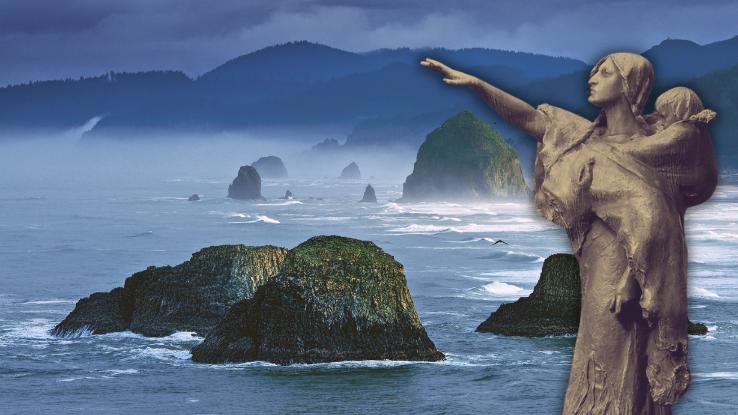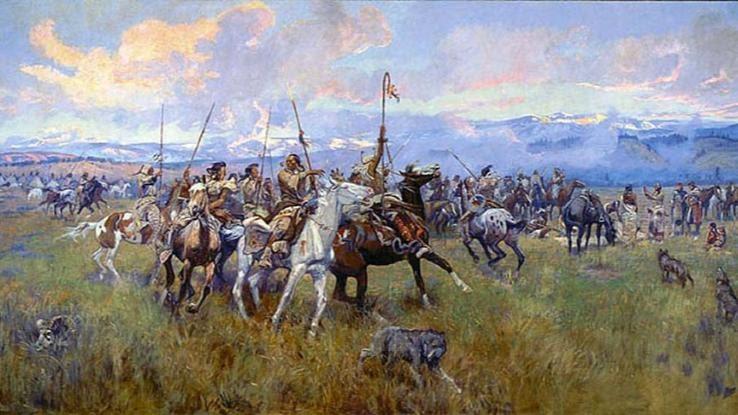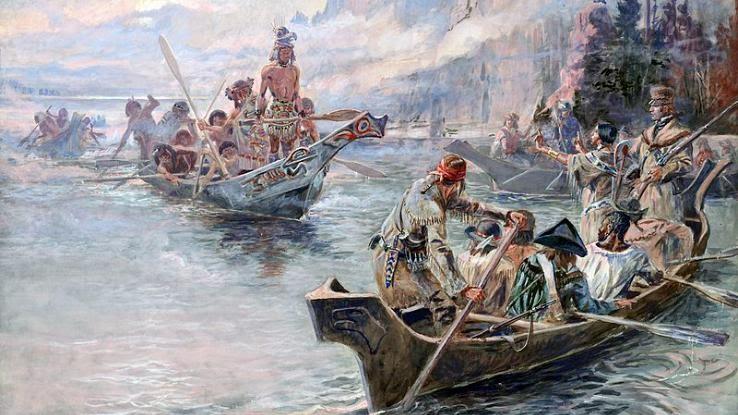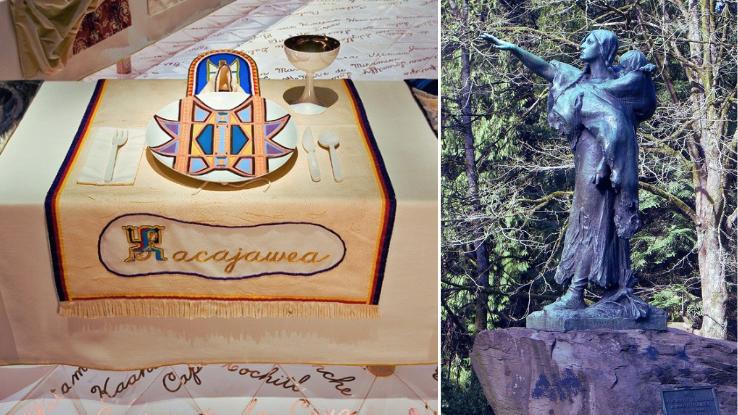Islamic Art in the Book Brief History of Art by Stokstad

If you learned of Sacagawea in your high-schoolhouse history class, it's probable that you think of her as a central part of the Lewis and Clark Expedition. But the common depiction of Sacagawea is thoroughly distorted; many truths almost her, and her circumstances, have either been twisted or left out entirely in order to adjust a detail narrative. That is, the expedition was meant to exist a heroic, American endeavor, and, as such, it'southward oftentimes romanticized by historians.
Notwithstanding, romanticizing the colonization of Ethnic peoples and lands is harmful — and using Sacagawea as a symbol of this alleged "heroic" mission is even more damaging. With this in heed, we're disclosing key aspects of Sacagawea's life in observance of Women's History Month.
Sacagewea's Early Years
Built-in effectually 1788 or 1789 into the Lemhi Shoshone ring of the Northern Shoshone, Sacagawea was part of the Agaidika people, or "Salmon-eater" Shoshone, and grew up in what is present-mean solar day Idaho. Although some accounts suggest that her proper name is Hidatsa in origin, with "sacaga" meaning "bird" and "wea" meaning "woman," many Shoshone people maintain that it's a Shoshone name that means "boat launcher" and is pronounced more than like "Sacajawea" (via National Women's History Museum).

"Cagaagawia'sh, in Hidatsa, or Birdwoman, in English, has get an important figure in both American Indian history and identity and as an icon of the women's suffrage movement," Alisha Deegan (Hidatsa/Sahnish), a denizen of the Mandan, Hidatsa, and Arikara Nation in North Dakota, and the estimation and cultural resources plan manager at Knife River Indian Villages National Historic Site, told Teen Faddy. Deegan goes on to notation that, "At that place are many questions virtually Cagaagawia'sh and her life, simply what we do know demonstrates that she was an amazing and strong woman."
Effectually 1800, when she was only 12 years old or then, Sacagawea and several other young Shoshone girls were kidnapped past Hidatsa warriors and, afterwards, enslaved. Over the next few years, Sacagawea became fluent in the Hidatsa language, a course of Siouan language spoken in what is now considered present-day Due north Dakota.
It'south around this signal in her story that details go a fleck murkier. Nevertheless, it is known that around 1803 or 1804, Sacagawea was sold as an enslaved person to, or "won" by, a French-Canadian fur trapper named Toussaint Charbonneau. Along with several other unknown Indigenous girls, Sacagawea was made to be ane of Charbonneau's "wives." Although many history textbooks shy away from the truth, playwright and activist Carolyn Gage does not, writing that this was "a formalized kid-rape arrangement brokered by adults," who also enslaved said kid.
In 1803, President Thomas Jefferson purchased western territory that had been claimed by French colonizers. Known every bit the Louisiana Purchase, this act nearly doubled the size of the U.s.a.. At that point, much of the middle of the continent had gone unexplored by white settlers. In order to map a safe route from the Eastward Coast to the Pacific Ocean, Jefferson hired explorer Meriwether Lewis and frontiersman William Clark to pb an trek of roughly 40 men up the Missouri.

While spending the winter months at an encampment nearly the Hidatsa-Mandan villages, Lewis and Clark met Charbonneau, who angled to bring together the expedition as an interpreter. The explorers allowed Charbonneau to bring together them, simply it was clear that they saw Sacagawea, who was just 16 or 17 years old at the time, every bit more of an asset to their colonialist expedition than Charbonneau, who Lewis later called "a homo of no peculiar merit" in his writings.
Non only was Sacagawea an interpreter herself, just she was also significant at the fourth dimension, and it's articulate that Lewis and Clark felt the optics of having an Indigenous mother with them — an expedition of generally white men — was benign. That is, the Corps of Discovery probable thought that Indigenous people they encountered wouldn't recall of them as a war political party if Sacagawea was with them. While Sacagawea's abilities (and very presence) were deemed important by the Corps, it'south important to notation that she didn't have any bureau over joining or non joining the expedition.
In addition to guiding the Corps of Discovery, Sacagawea was able to identify edible plants, communicate with other Ethnic people they encountered, and, in one example, ensured the survival of the expedition'southward documentation. That is, when a gunkhole about capsized, Sacagawea collected all of the journals, navigational tools, and provisions that might have otherwise been lost — all while carrying her baby, and Jean-Baptiste (nicknamed "Pompey"), on her back. Indebted to her efforts, Lewis and Clark named the Sacagawea River, which flows through nowadays-twenty-four hour period Montana, after her.
In July of 1805, the expedition reached the three forks of the Missouri River, which Sacagawea recognized. Nigh a month subsequently, the Corps encountered Shoshone peoples and, in a twist of fate, Sacagawea realized that the main, Cameahwait, was her brother. By that fall, the Corps reached the Pacific Ocean, thanks in big part to the horses the Shoshone people provided them.
Needing a place to set up their wintertime encampment, the Corps once more leaned on Sacagawea's knowledge. Simply determining where to install Fort Clatsop wasn't the last time Sacagawea'due south insights proved invaluable. In fact, on the return journey, it was Sacagawea who safely guided the group she was with through what's known today as the Bozeman Laissez passer, an act that caused Clark to notation that she had been "a airplane pilot through this land."
Despite the instrumental function she played, Sacagawea was non given any compensation; the same was truthful for York, the enslaved Black human being who besides made the roundtrip journey with the Corps. Sacagawea'southward captor, on the other hand, was given $500 and over 300 acres of land, despite Lewis' dislike of him.
Sacagewea's Legacy Today
In that location isn't much in the way of written documentation when it comes to Sacagawea's life after the trek. It is well documented that Sacagawea's son was left in the care of Clark, who was (strangely) eager to oversee the boy's education in St. Louis. Later on that, Sacagawea seemingly went on fur-trading expeditions and gave birth to a daughter, Lisette, in 1812.

When it comes to her death, at that place's quite a chip of uncertainty, too. While records from a fur-trading mail note that she died of typhus in 1812, other accounts point that she didn't pass away at but 25 years old. The National Women's History Museum points to Indigenous oral histories, some of which suggest that "Sacagawea lived for many more than years in the Shoshone lands in Wyoming, until her death in 1884."
Cultura Colectiva points out that, "In 1925, Dr. Charles Eastman, an Indigenous physician, was sent by the Bureau of Indian Diplomacy to look for the remains of the great Sacagawea." In retracing Sacagawea's steps, Dr. Eastman learned of a Shoshone adult female, who went by the name Porivo and lived on a Comanche reservation; Dr. Eastman believed this elderberry to exist Sacagawea.
"Though information technology is known that she separated from the abusive Charbonneau, little else is certain almost the remainder of Sacajawea's life," the Brooklyn Museum notes. "Well-nigh Native people believe she died in 1812 at Fort Mandan and is buried somewhere on the Standing Rock Sioux reservation lands, North Dakota, while some evidence states that she lived with the Shoshone tribe for many years after."
In fact, Sacagawea has two "official" burial sites. One, in Corson Canton, South Dakota, aligns with the story that she died at just 25 years sometime. This site, located at Fort Manuel, was placed on the National Annals of Historic Places in 1978 as the final resting identify of Sacagawea, but this completely discounts the oral history collected by both Dr. Eastman and Dr. Grace Hebard. The second site is located at Fort Washakie in the Air current River Reservation in Wyoming.
According to the National Park Service, there are more statues dedicated to Sacagawea than any other adult female in American history. Unveiled in 1905, Alice Cooper's Sacagawea and Jean-Baptiste is one of the virtually notable monuments. Often, the sculpture is credited with inspiring now-controversial writer Eva Emery Dye, who, in writing, cemented the romanticization and colonialist depiction of Sacagawea.
Additionally, the National American Woman Suffrage Clan, perchance not realizing the total story, saw Sacagawea every bit a symbol of women's independence. And, in 2000, the U.S. Mint aimed to accolade her with a golden dollar money, but press the likeness of someone who was enslaved by white men on currency is, to say the very least, a problematic selection.
But attempts to honor Sacagawea go across monuments, misguided coins and named natural landmarks. In fact, she is the only Indigenous woman represented in feminist artist Judy Chicago'southward installation The Dinner Party, which features identify settings for prominent, history-making women. "The circumstances surrounding her life accept become the stuff of fable, prompting estimation by historians, writers, and filmmakers," the Brooklyn Museum, which houses The Dinner Party, notes. "In an era in which women, particularly Native American women, were considered either weak and helpless or dangerous, Sacajawea proved to be an icon of bravery."
In a letter of the alphabet entitled "To the Youth / OUR FUTURE," Canadian First Nations artist George Littlechild ponders Sacagawea's complicated, but important, legacy. "Information technology is a known fact that America glorifies historical figures such as Lewis and Clark, that they are commemorated for opening up the West to 'Progress,' thus 'Civilizing' ancestral lands," he writes. "They accept become cultural icons for their deeds…. In fact what did they truly do for this country known every bit America?"
Venerated by some but rightly despised by others, Lewis, Clark and the whole expedition were harbingers of the destruction, disease, and expiry that was still to come with the United States' westward expansion. "It is up to us to rewrite the history books," Littlechild writes, "to brand alter and higher up all to accept respect for all humanity…" And, in part, that can start with looking beyond whitewashed history to sympathize historical figures like Sacagawea more honestly.
plummerupostionots.blogspot.com
Source: https://www.reference.com/history/sacagawea-life-story?utm_content=params%3Ao%3D740005%26ad%3DdirN%26qo%3DserpIndex
0 Response to "Islamic Art in the Book Brief History of Art by Stokstad"
Post a Comment